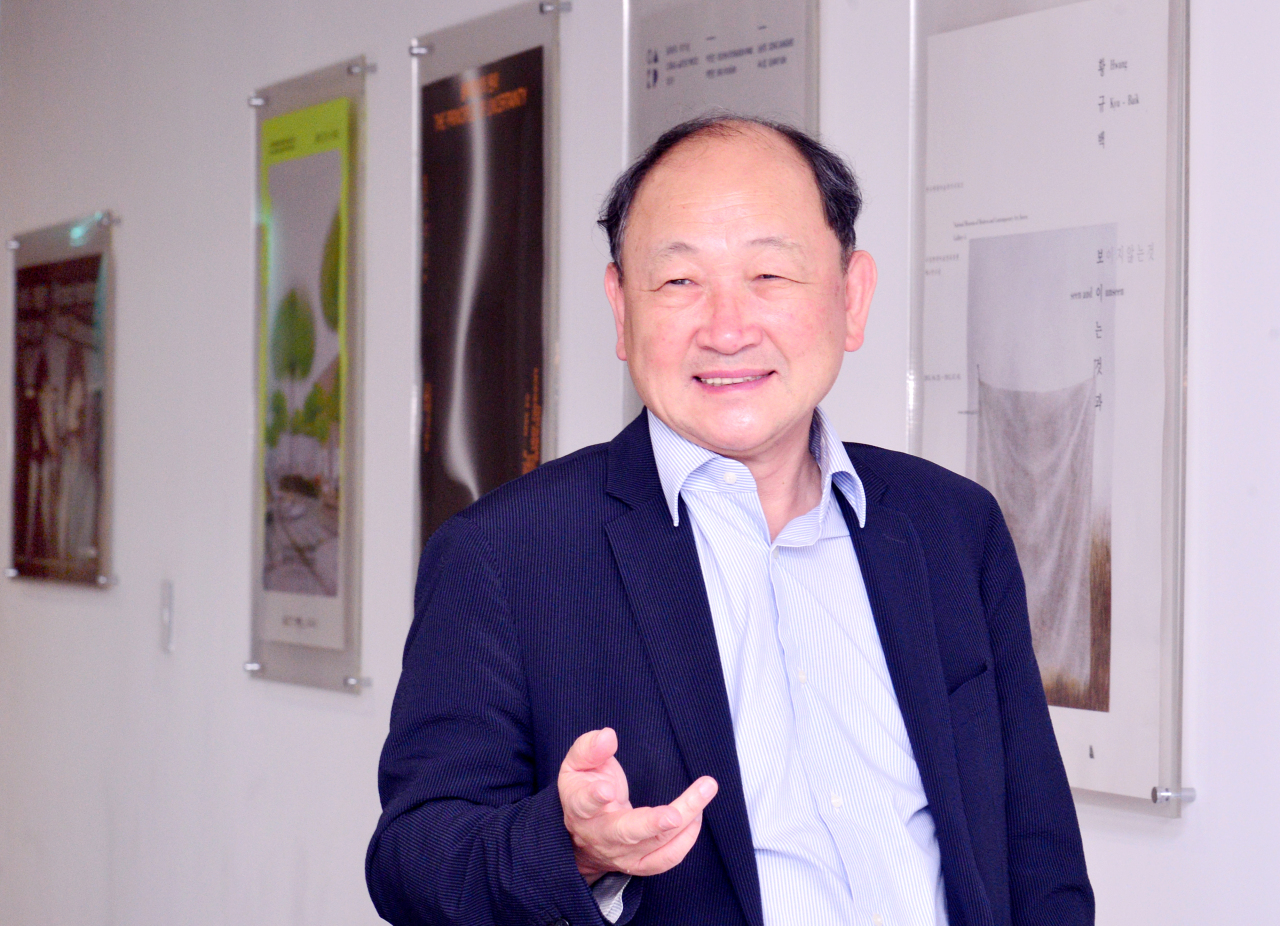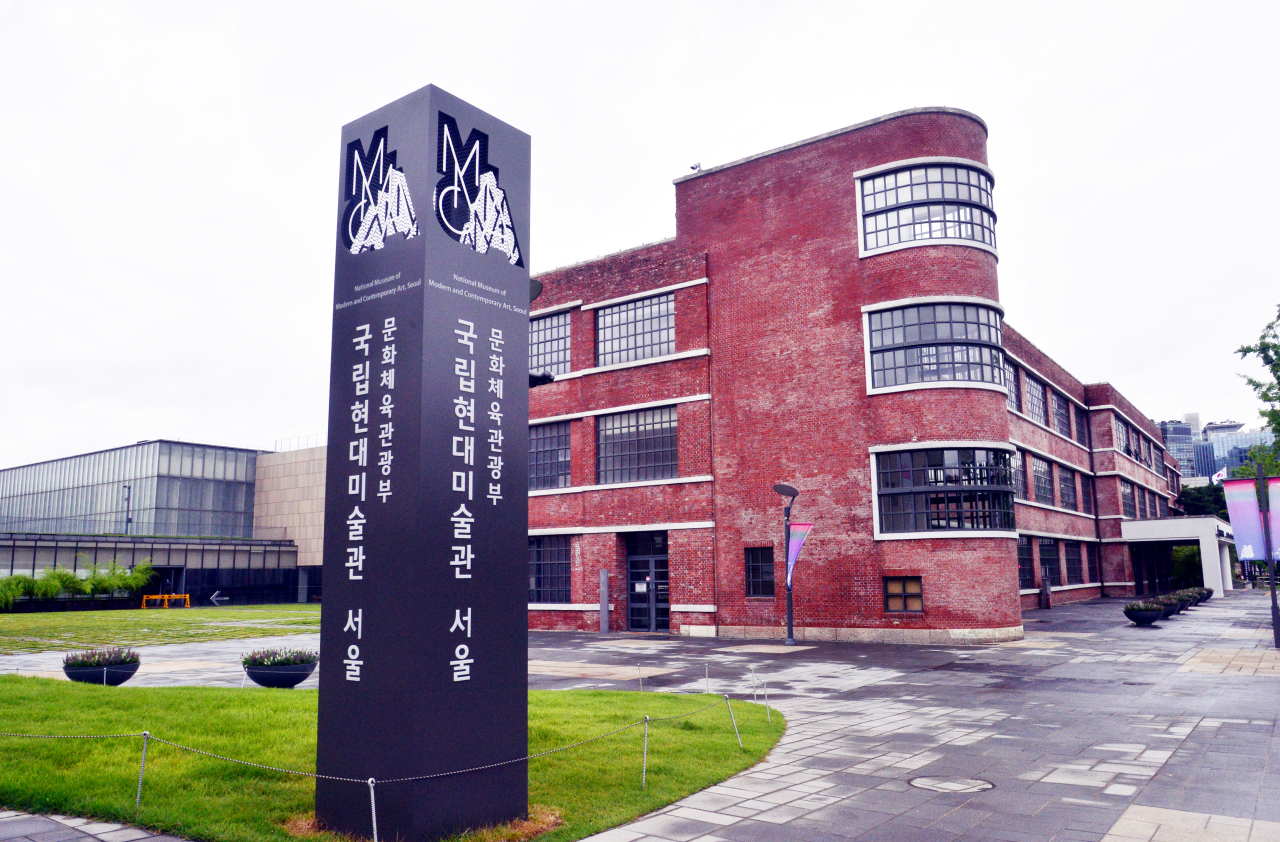 |
Youn Bum-mo, director of the National Museum of Modern and Contemporary Art, Korea, speaks during an interview with The Korea Herald at MMCA Seoul on Tuesday. (Park Hyun-koo/The Korea Herald) |
Sometimes a crisis turns into an opportunity. When COVID-19 began to spread across the country, the National Museum of Modern and Contemporary Art, Korea (MMCA) quickly moved online in March, grabbing global attention for its digital content.
More than 3,000 people viewed the museum‘s first live-streamed exhibition, its first calligraphy-only exhibition in its 51-year history, on the museum’s YouTube channel. “The Modern and Contemporary Korean Writing,” a 80-minute curator-guided tour with English subtitles has now reached nearly 80,000 views.
“After we strengthened our online contents, we have been receiving numerous requests to reopen the museum as soon as possible and messages from different countries that show interest in how we cope with COVID-19,“ MMCA Director Youn Bummo told The Korea Herald on Tuesday during an interview conducted at MMCA Seoul in Jongno-gu, central Seoul.
MMCA launched the “Online Museum” section on its website in March for online offerings that include a series in which Youn explains MMCA’s collections. The museum has created 536 online contents so far for online platforms, including YouTube, social media and the online museum section of its website.
Even after the pandemic situation is resolved, the museum will continue to reinforce its online contents and will include an online production budget for each exhibition to reach a wider range of people from home and abroad, Youn said.
Among the museum’s four venues – MMCA Gwacheon, MMCA Seoul, MMCA Deoksugung, and MMCA Cheongju – the three museums in the capital area are currently closed due to COVID-19 in compliance with the government’s guideline. The Cheongju venue in North Chungcheong province is currently running the exhibition, “Conservator C’s Day.”
Although the government’s guideline requires MMCA to remain closed until daily COVID-19 infection cases fall to under 10, the museum is seeking ways to open earlier, appealing to the government to move up the reopening day.
“An art museum is a safer place compared to other cultural facilities. And even more, people heal their minds through artworks. I think the museum should play a role in comforting people during the pandemic time,” he said. “We are aiming to reopen as soon as possible.”
When it reopens, the museum will institute measures such as requiring reservations to enter the museum and limiting the number of people viewing each art piece.
 |
A view of the National Museum of Modern and Contemporary Art, Korea in Jongno-gu, central Seoul (Park Hyun-koo/The Korea Herald) |
If it opens soon, Youn hinted that the museum will surprise visitors with something experimental – an exhibition for their companion dogs.
The exhibition “The Museum for All, Museum for Dogs,” which was originally scheduled to open in May, only to be pushed back to September due to COVID-19, consists of content for dogs. The idea for the novel exhibition began with challenging questions: Is a museum only for humans? Can we break the stereotypes that exisit about museums?
When a young curator suggested the idea half in jest, Youn did not turn it down. Rather, he encouraged the idea with a belief that a museum should be a place that ”charges one’s imagination.“
“In Korea, one third of households have a companion animal, which is a huge population,” Youn said. “Contemporary art is about diversity, and we wanted to set up a new concept about a museum. Sometimes, a preposterous idea becomes a driving force that changes history.”
Museum with pride
MMCA plans to publish books on Korean modern art in English titled “Korean Art Since 1990” and “MMCA Collection 300” next year to promote a better understanding of Korean fine arts, which will ultimately lead to more foreign visitors to the museum.
Youn said the museum is aiming to publish a book on Paik Nam-june, the pioneer of video art, to address the gap in reliable sources on the Korean-born artist.
“We have planned an archival exhibition on Paik Nam-june, which is expected to be held next year. Our curators have gone through nearly 500 pieces of research on him and plan to publish a book that helps understand his art,” Youn said. “Paik is an important figure in Korea because so many video artists have emerged in Korea since Paik.”
 |
A view of the National Museum of Modern and Contemporary Art, Korea in Jongno-gu, central Seoul (Park Hyun-koo/The Korea Herald) |
“Establishing pride in Korea’s modern art” is Youn‘s guiding philosophy in running the museum, and the calligraphy exhibition in March was part of that philosophy.
“Traditionally, calligraphy such as letters and paintings were thought to go hand in hand. Contemporary paintings that reflect the idea are close to extinction now,” Youn said. “As a national museum, it was important to shed light on calligraphy works and ink paintings.”
While Korean abstract paintings such as dansaekhwa have been recognized globally in recent years, other genres such as Korean Avant-garde art of the 1960s and 1970s; Minjung Art that emerged in the 1980s against authoritarian regimes; Minhwa, Korean folk paintings that originated in the royal palaces are also deserving of global spotlight, according to Youn.
“Minjung Art was born in collaboration between civilians and painters as part of democratization movement, which is historically unique not only in Korea but also to the world,” Youn said. “As for Korea’s experimental art, it bloomed here when the country was going through difficult times following the Korean War. During the time, several innovative artists such as Lee Seung-taek appeared, interpreting subjects in a totally different context.”
MMCA Seoul will present a retrospective of Avant-garde artist Lee Seung-taek, who used natural phenomenon such as water, fire, wind and sound in air, at the end of the year, showcasing around 150 artworks and 100 documentaries at MMCA Seoul.
By Park Yuna (
yunapark@heraldcorp.com)










![[Today’s K-pop] Blackpink’s Jennie, Lisa invited to Coachella as solo acts](http://res.heraldm.com/phpwas/restmb_idxmake.php?idx=644&simg=/content/image/2024/11/21/20241121050099_0.jpg)